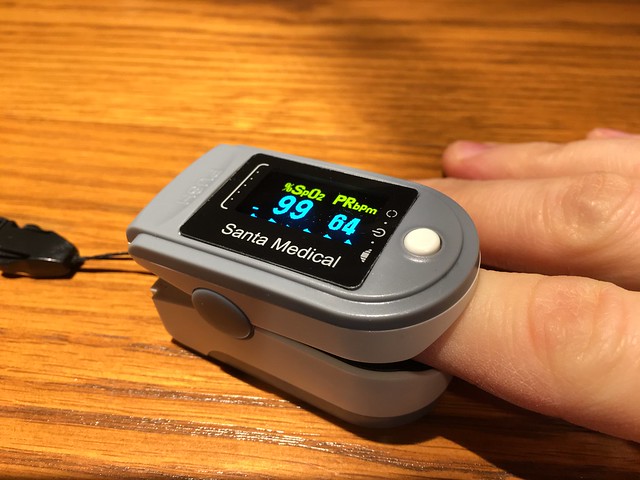You are here
Using a Pulse Oximeter to Monitor Oxygen Saturation and Pulse Rate
If you can make use of a reasonably accurate way of almost instantly monitoring your oxygen saturation (SO2) level, you might consider utilizing an inexpensive pulse oximeter, as shown above.
A pulse oximeter provides an non-invasive way of assessing peripheral oxygen saturation as well as pulse rate. The technology employed to determine pulse rate is a sensor that is now widely used in wearable devices like the Apple watch to monitor pulse rate.
It's important to note that peripheral oxygen saturation - as indicated by a pulse oximeter - is not exactly the same as arterial oxygen saturation as measured through a blood test (with blood from an artery, not a vein), but these two measures are correlated strongly enough that you can rely on the readings of a portable pulse oximeter to quickly obtain some measure of your level of oxygenation and overall health status.
Portable pulse oximeters are especially useful to those with chronic lung, heart, blood, and circulatory challenges who may need supplemental oxygen from time to time. They're also helpful to pilots, mountain climbers, and athletes whose O2 levels can decrease at high altitudes and with intense exercise. Some high level athletes will mark their progress over training blocks by charting their pulse rate and oxygen saturation readings before, during, and after training sessions.
Using a pulse oximeter is quite simple. You place the end of one of your fingers into the device, and within about 10 seconds, the photodetector within a pulse oximeter will display your peripheral oxygen level.
In the absence of chronic obstructive pulmonary disease, a normal range for peripheral oxygen level is 95 to 99 percent.
Though a pulse oximeter is useful for quickly measuring oxygen saturation, please note that it doesn't measure ventilation or how much oxygen is actually being used at a cellular level, so where there is significant lung disease, it's important to work with a physician who can monitor blood gases and other relevant parameters. There are certain conditions and circumstances like anemia and being in cold temperatures, respectively, where a pulse oximeter will give readings within normal range but where a person needs more oxygen than he or she has hemoglobin to carry, so it's best to consult with a health care provider when wanting to investigate reasons for a low reading.
Nowadays, you can find inexpensive portable pulse oximeters at pharmacies and even at Amazon. The unit that I use on an everyday basis can be found here:
I find this unit to be quite accurate and easy to use with a self-adjusting finger clamp. You slip your finger in while remaining relatively still, press one button, and within seconds, the device will display your oxygen saturation level and pulse rate.
If you have any questions about using a portable pulse oximeter, please feel free to write to me directly at benkim@drbenkim.com.







